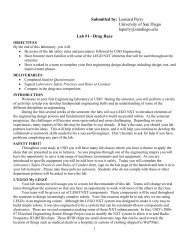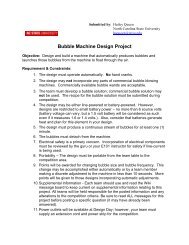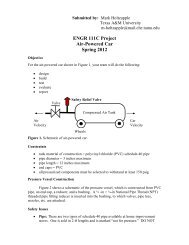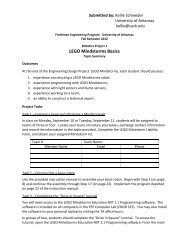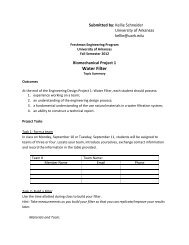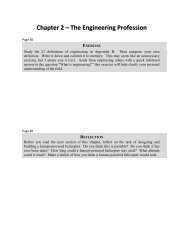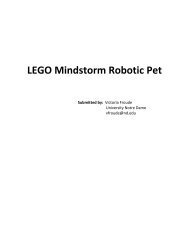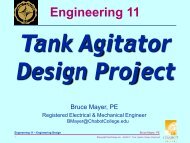P100 - Chemical Engineering Process Design ... - Discovery Press
P100 - Chemical Engineering Process Design ... - Discovery Press
P100 - Chemical Engineering Process Design ... - Discovery Press
You also want an ePaper? Increase the reach of your titles
YUMPU automatically turns print PDFs into web optimized ePapers that Google loves.
<strong>Chemical</strong> <strong>Engineering</strong> <strong>Process</strong><br />
<strong>Design</strong> Competition<br />
Submitted by: Mike Duncan<br />
Cornell University<br />
tmd10@cornell.edu
<strong>Design</strong> Competition Overview - 2012<br />
Produce P by the reaction A → P, which is accompanied by a parallel reaction, A → X. Both<br />
reactions are irreversible and both reactions are incomplete. Reactant A is available only as a<br />
mixture with inert impurity I. A, I, and P have identical boiling points; we obtain pure P with a<br />
liquid-solid separator.<br />
The simplest design is a reactor and a separator.<br />
P (liquid)<br />
A and I<br />
reactor<br />
A → P<br />
A → X<br />
A, I, P, and X<br />
liquid-solid<br />
separator<br />
purge<br />
solids A, I, and X,<br />
wet with liquid P<br />
You may decide to recycle unreacted A, with a purge to remove impurity I and by-product X.<br />
P (liquid)<br />
A and I<br />
A, I, P, and X<br />
reactor<br />
A → P<br />
A → X<br />
A, I, P, and X<br />
liquid-solid<br />
separator<br />
A, I, P, and X<br />
solids A, I, and X,<br />
wet with liquid P<br />
purge<br />
Or you may install a gas-liquid separator to purify by-product X, which can also be sold.<br />
P (liquid)<br />
A and I A, I, P, and X reactor A, I, P, and X liquid-solid<br />
A → P<br />
separator<br />
A → X<br />
A, I, and P<br />
solids A, I, and X,<br />
wet with liquid P<br />
X<br />
gas-liquid<br />
separator<br />
A, I, P, and X<br />
purge
<strong>Design</strong> Competition - 2012<br />
You have two choices for the reactant purity:<br />
Grade 1: High purity (at least 95 mol% A) and high price.<br />
Grade 2: Modest purity (at least 80 mol% A) and modest price.<br />
You have two choices for the reactor:<br />
Type 1: High conversion and modest selectivity of P over X.<br />
Type 2: Low conversion and good selectivity of P over X.<br />
You have two choices for the liquid-solid separator:<br />
Type 1: High recovery of P; low mol% P in the solids stream.<br />
Type 2: Good recovery of P; modest mol% P in the solids stream.<br />
In general, equipment with better specifications costs more to purchase and costs more to operate.<br />
The equipment has economy of scale; the equipment price is proportional to (capacity) 0.6<br />
For the first year, you must decide what grade of reactant to use, what types of equipment to<br />
purchase, what size equipment to purchase, and your production rates. Economic data are<br />
provided in a separate file.<br />
Your fiducial goal is to achieve an ROI greater than zero. Additional rewards are earned for an<br />
ROI greater than 0.20 and for the highest ROI in your Division.
EngrI 1120 - Introduction to <strong>Chemical</strong> <strong>Engineering</strong><br />
<strong>Design</strong> Competition - Fall 2012 - Part 1.<br />
Your company has decided to produce P by the reaction A → P. Unfortunately, there is a parallel reaction,<br />
A → X. Both reactions are irreversible and both reactions are incomplete. Reactant A is available<br />
only as a mixture with inert impurity I.<br />
A, I, and P have identical boiling points; we obtain pure P with a liquid-solid separator. But the solids A,<br />
I, and X retain some liquid P.<br />
A generic process is shown below. To produce and sell product P, you need only a reactor and a liquidsolid<br />
separator. You have three options for the A+I+P+X mixture in the liquid-solid separator bottoms<br />
stream: (1) you may discard the mixture by sending 100% of the stream to the purge, or (2) you may<br />
recycle some of the mixture, for example, by purging 50% and sending 50% through the recycle, or (3)<br />
you may purchase a second separator to separate and sell by-product X. If you wish to produce X, the<br />
bypass plus purge must be less than 100%.<br />
P (liquid)<br />
to market<br />
A and I<br />
recycle<br />
A, I, P, and X<br />
reactor<br />
A → P<br />
A → X<br />
A, I, P, and X<br />
liquid-solid<br />
separator<br />
gas-liquid<br />
separator<br />
tops<br />
A, I, P, and X<br />
A, I, P, and X<br />
A, I, and P<br />
bypass<br />
liquid-solid<br />
separator<br />
bottoms<br />
solids A, I, and X,<br />
wet with liquid P<br />
to market<br />
X<br />
gas-liquid<br />
separator<br />
purge<br />
A, I, P, and X<br />
There are two options for reactant purity. Grade 1 mixture is high purity A and is expensive. Grade 2<br />
mixture is modest purity A and is less expensive.<br />
There are two options for the reactor. Reactor Type 1 has a high conversion of A but has modest<br />
selectivity for P over X. Reactor Type 2 has a lower conversion of A, but better selectivity for P over X.<br />
There are two options for the liquid-solid separator. Both options produce pure P, but differ by the<br />
amount of P retained by the solids. Liquid-solid separator Type 1 recovers more P. Liquid-solid<br />
separator Type 2 retains more P in the solids stream, but is less expensive to operate.<br />
Disposal of the purged stream requires special treatment and is expensive.
<strong>Engineering</strong> and Economic Data for Manufacturing P (and X) from A.<br />
Equipment specifications, equipment costs, operating costs, chemical costs, and disposal costs vary with<br />
<strong>Design</strong> League and Division. Identify your team’s League and Division and then download the data from<br />
the EngrI 1120 homepage - see “<strong>Design</strong> Competition.”<br />
Wednesday <strong>Design</strong> League:<br />
Thursday <strong>Design</strong> League:<br />
Keynes Division: Teams W1 - W7<br />
Smith Division: Teams W8 - W13<br />
Friedman Division: Teams R1 - R6<br />
Galbraith Division: Teams R7 - R13<br />
Reactor and separator prices are given by the formula price = k × (F T ) 0.6 , where k is a constant<br />
conversion factor, F T is the flow through the unit, in mol/day, and price is in $. For example, a reactor<br />
with double the capacity costs only 1.5 times as much. Operating costs for reactors and separators are<br />
given by the formula operating cost = c × F T ; the units of operating cost are $/year.<br />
All economic parameters - equipment prices, operating costs, chemical prices, and disposal cost - are<br />
constant. Equipment depreciation is calculated with straight-line formula, with a lifetime of 10 years.<br />
The process operates 365 days/year.<br />
Equipment purchase costs are paid at the beginning of the year. Operating costs are paid during the year.<br />
Revenue from sale of P (and perhaps, X) is received at the end of the year.<br />
_________________________________<br />
Goal: Start with $10,000,000 and maximize the ROI for your process in the first year.<br />
You must decide what grade of reactant purity and what type of reactor and liquid-solid separator to<br />
purchase, and the capacity of each. You must decide if you wish to purchase a gas-liquid separator to<br />
purify and sell by-product X.<br />
You must specify the fraction of liquid-solid separator bottoms to be purged and the fraction to be<br />
recycled. You also must decide how much reactant to purchase.<br />
Annual Plans are due by 2:30 p.m. on the day of your Calculation Session, either October 17 or October<br />
18. You will receive an Annual Report of your team’s results by Friday, October 19.<br />
If your team achieves a positive Return On Investment, your team will earn 25 homework points. If your<br />
ROI is greater than 0.2, your team will earn an additional 10 points. If your team has the highest Return<br />
On Investment in your Division, your team will be bestowed an additional 10 points.<br />
Hint: There are eight combinations of reactant grade, reactor type, and liquid-solid separator type. Every<br />
combination can be operated to produce a positive ROI. Half of the combinations can be operated to<br />
produce an ROI greater than 0.2.
EngrI 1120 - Introduction to <strong>Chemical</strong> <strong>Engineering</strong><br />
<strong>Design</strong> Competition - Fall 2012 - Part 2.<br />
In addition to buying reactant mixture A+I and selling product P (and perhaps, X), you may buy and sell<br />
intermediate compositions by trading with other companies. For example, you may decide to buy only a<br />
reactor – no separators. Because the reactor price scales non-linearly, your reactor will produce reactor<br />
effluent cheaper than smaller reactors. You could supply other companies with reactor effluent at a price<br />
below their cost to manufacture it. Both companies may benefit.<br />
Or perhaps your company may decide to invest in a large gas-liquid separator to purify X. Perhaps your<br />
company can charge less than the disposal cost for purged waste. So other companies will give you<br />
liquid-solid separator bottoms and pay you a fee less than the disposal cost. You can sell by-product X.<br />
All companies may benefit.<br />
The process flowsheet is modified as follows:<br />
from<br />
other<br />
team(s)<br />
to other<br />
team(s)<br />
A and I<br />
A<br />
I<br />
P<br />
X<br />
recycle<br />
A, I, and P<br />
A, I, and P<br />
reactor<br />
A → P<br />
A → X<br />
A, I, P, and X<br />
A<br />
I<br />
P<br />
X<br />
bypass<br />
to<br />
other<br />
team(s)<br />
A<br />
I<br />
P<br />
X<br />
from<br />
other<br />
team(s)<br />
A<br />
I<br />
P<br />
X<br />
liquid-solid<br />
separator<br />
bottoms<br />
P (liquid)<br />
liquid-solid<br />
separator<br />
to market<br />
solids A, I, and X,<br />
wet with liquid P<br />
to other<br />
team(s)<br />
to market<br />
X<br />
gas-liquid<br />
separator<br />
A, I, P, and X<br />
purge<br />
from<br />
other<br />
team(s)<br />
What price to charge for reactor effluent? What price to pay for reactor effluent? What fee to charge for<br />
disposing purged mixtures? Prices and fees must be negotiated between companies.<br />
Trading with other companies is optional; you may eschew intercompany entanglements and operate<br />
independently.<br />
Rules:<br />
This is a new competition. Every team is starting with $10,000,000 and no equipment. The costs and<br />
equipment specifications are unchanged from the previous competition.<br />
Annual Plans and (optional) Contracts are due by 3:00 p.m. on the day of your Calculation Session, either<br />
October 24 or October 25. You will receive an Annual Report of your team’s results by Friday, October<br />
26.<br />
continued on the back ...
More Rules.<br />
Teams may write contracts with other teams in their League and Division only.<br />
Because a company will depend on another company fulfilling the contract, the contracts have a provision<br />
for penalties. For example, if a company agrees to supply Reactor Type-1 effluent at 50.0 mol/day, but<br />
fails to do so, that company must pay the penalty stated on the contract.<br />
Contracts are valid for one year only. If you want a perpetuity arrangement, you must write contracts for<br />
years one (1) and two (2).<br />
Services and cash from contracts (see below) exchange during the year.<br />
Company X may not give its money to company Y, even if company X has a contract to be repaid by<br />
company Y, with interest or a share of the profits. This contract is essentially a merger of two companies<br />
into a single company with twice the assets. The competition is intended to exercise engineering design<br />
and negotiation skills, so all companies should start with the same resources.<br />
For subsequent years, each company may spend the amount listed on the line “cash at end of year” plus<br />
money received by contract(s). If your company does nothing in year 1, your company has $10,000,000<br />
(plus or minus money by contract(s)) in year 2.<br />
Every contract must be a reasonable exchange of process streams and/or cash. Every contract must be<br />
explicit. Cash amounts must be specific numbers. For example, contracts with payments described as<br />
“half the profits” will not be accepted.<br />
Equipment may not be exchanged between companies. If your company needs additional processing<br />
capacity and another company has excess processing capacity, your companies should arrange to<br />
exchange process streams, such as reactor effluent, or liquid-solid separator bottoms, for example.<br />
In the second year, new equipment may be purchased to increase the size of an existing process, and/or<br />
new equipment may be purchased to create a new process.<br />
In summary, Annual Plans and InterCompany Contracts must be unambiguous. Add comments to indicate<br />
precisely how each equipment purchase is to be used. If you have questions, please ask. I will try to<br />
respond promptly to e-mail by the next business day and I am available during office hours, 1:30-3:30<br />
p.m. Mondays.<br />
Goal: Start with $10,000,000 and maximize the net value of your process after two years. The net value<br />
of a company is cash plus depreciated value of equipment.<br />
For each week that your team achieves a positive Return On Investment, your team will earn 25 homework<br />
points. If your ROI is greater than 0.2, your team will earn an additional 10 points. For each week<br />
that your team has the highest Return On Investment in your Division, your team will be bestowed an<br />
additional 10 points.
Equipment Specifications and Economic Data for Manufacturing P (and X) from A.<br />
Reactor and separator prices are given by the formula price = k × (F T ) 0.6 , where k is a constant<br />
and F T is the flow through the unit, in mol/day.<br />
Operating costs for reactors and separators are given by the formula operating cost = c × F T . The<br />
units are $/year. So if c = 2500 and you have a unit operating with a flow rate of F T = 300<br />
mol/day, the annual operating cost is 2500 * 300 = $750,000 / year.<br />
Tables of constants k and c appear below. Be careful to select the data for your League and Division.<br />
All economic parameters - equipment prices, operating costs, chemical prices, and disposal cost -<br />
are constant. Equipment depreciation is calculated with straight-line formula, with a lifetime of 10<br />
years. Your process operates 365 days/year.<br />
-----------------------------------------------------------<br />
Wednesday <strong>Design</strong> League - John Maynard Keynes Division 2012 - Teams W1 - W7.<br />
reactant mixture grade 1 (98 mol% A)<br />
reactant mixture grade 2 (94.5 mol% A)<br />
$31/mol<br />
$22/mol<br />
k<br />
c<br />
reactor, type 1 (57% conversion of A, P:X = 4:1) $75,000 $2,700<br />
reactor, type 2 (38% conversion of A, P:X = 10:1) $52,000 $2,100<br />
liquid-solid separator type 1 (P retained by solids = 3 mol% of solids) $65,000 $2,200<br />
liquid-solid separator type 2 (P retained by solids = 8 mol% of solids) $47,000 $1,700<br />
gas-liquid separator $30,000 $3,800<br />
Product P sells for $111/mol. By-product X sells for $37/mol.<br />
Disposal of purged waste costs $6/mol.<br />
-----------------------------------------------------------<br />
Wednesday <strong>Design</strong> League - Adam Smith Division 2012 - Teams W8 - W14.<br />
reactant mixture grade 1 (93 mol% A)<br />
reactant mixture grade 2 (81 mol% A)<br />
$35/mol<br />
$18/mol<br />
k<br />
c<br />
reactor, type 1 (85% conversion of A, P:X = 2:1) $78,000 $2,300<br />
reactor, type 2 (55% conversion of A, P:X = 8:1) $49,000 $2,100<br />
liquid-solid separator type 1 (P retained by solids = 5 mol% of solids) $62,000 $1,800<br />
liquid-solid separator type 2 (P retained by solids = 18 mol% of solids) $34,000 $1,400<br />
gas-liquid separator $35,000 $3,400<br />
Product P sells for $106/mol. By-product X sells for $33/mol.<br />
Disposal of purged waste costs $6/mol.<br />
-----------------------------------------------------------
Thursday <strong>Design</strong> League - Milton Friedman Division 2012 - Teams R1 - R6.<br />
reactant mixture grade 1 (97 mol% A)<br />
reactant mixture grade 2 (90 mol% A)<br />
$29/mol<br />
$15/mol<br />
k<br />
c<br />
reactor, type 1 (33% conversion of A, P:X = 3:1) $45,000 $2,500<br />
reactor, type 2 (22% conversion of A, P:X = 8:1) $22,000 $1,800<br />
liquid-solid separator type 1 (P retained by solids = 5 mol% of solids) $22,000 $1,800<br />
liquid-solid separator type 2 (P retained by solids = 13 mol% of solids $17,000 $1,600<br />
gas-liquid separator $12,000 $1,400<br />
Product P sells for $127/mol. By-product X sells for $47/mol.<br />
Disposal of purged waste costs $5/mol.<br />
-----------------------------------------------------------<br />
Thursday <strong>Design</strong> League - Kenneth Galbraith Division 2012 - Teams R7 - R13.<br />
reactant mixture grade 1 (95 mol% A)<br />
reactant mixture grade 2 (88 mol% A)<br />
$23/mol<br />
$15/mol<br />
k<br />
c<br />
reactor, type 1 (45% conversion of A, P:X = 1:1) $55,000 $2,200<br />
reactor, type 2 (30% conversion of A, P:X = 2:1) $39,000 $1,700<br />
liquid-solid separator type 1 (P retained by solids = 4 mol% of solids) $44,000 $1,600<br />
liquid-solid separator type 2 (P retained by solids = 13 mol% of solids) $29,000 $1,200<br />
gas-liquid separator $28,000 $2,400<br />
Product P sells for $155/mol. By-product X sells for $48/mol.<br />
Disposal of purged wastes costs $4/mol.<br />
-----------------------------------------------------------
EngrI 1120 - Introduction to <strong>Chemical</strong> <strong>Engineering</strong><br />
<strong>Design</strong> Competition - Annual Investment and Operation Plan - 2012<br />
Company<br />
Year<br />
Equipment Purchases:<br />
Reactor: Type: (1 or 2)<br />
Size: (capacity in mol/day or cost in $)<br />
Liquid-Solid Separator: Type: (1 or 2)<br />
Size: (capacity in mol/day or cost in $)<br />
(optional) Gas-Liquid Separator:<br />
Size: (capacity in mol/day or cost in $)<br />
Operating Parameters:<br />
Reactant A+I Purity: Grade: (1 or 2)<br />
Reactant A+I flow rate:<br />
(mol of A+I per day, or write MAXIMUM*)<br />
Fraction of Liquid-Solid Separator bottoms to purge:<br />
Fraction of Liquid-Solid Separator bottoms to bypass Gas-Liquid Separator**:<br />
Company Representative:<br />
*You need not calculate the exact flow rate of A+I. If you write “MAXIMUM,” we will process as much<br />
A+I as possible, limited by your equipment capacity or your cash remaining after buying equipment.<br />
** The sum of fraction purged plus fraction bypassed must be less than or equal to 1. If you do not<br />
purchase a gas-liquid separator (and therefore sell no by-product X), you must set the sum of fraction<br />
purged plus fraction bypassed to exactly 1.
EngrI 1120 - Introduction to <strong>Chemical</strong> <strong>Engineering</strong><br />
<strong>Design</strong> Competition - InterCompany Contract - 2012<br />
Year<br />
Company<br />
and<br />
Company<br />
(hereafter known as company 1) gives<br />
mol/day of reactant grade (1 or 2).<br />
mol/day of reactor effluent with at least mol% P.<br />
mol/day of liquid-solid separator bottoms with at least mol% A.<br />
mol/day of gas-liquid separator tops with at least mol% A.<br />
$ cash.<br />
(hereafter known as company 2) gives<br />
mol/day of reactant grade (1 or 2).<br />
mol/day of reactor effluent with at least mol% P.<br />
mol/day of liquid-solid separator bottoms with at least mol% A.<br />
mol/day of gas-liquid separator tops with at least mol% A.<br />
$ cash.<br />
Penalties:<br />
If company 1 fails to deliver, a penalty of $ will be paid to company 2.<br />
If company 2 fails to deliver, a penalty of $ will be paid to company 1.<br />
Signatures:<br />
Company 1 Representative:<br />
Company 2 Representative:
EngrI 1120 - Introduction to <strong>Chemical</strong> <strong>Engineering</strong><br />
Generic <strong>Process</strong> Flowsheet for the <strong>Design</strong> Competition - 2012<br />
to other<br />
team(s)<br />
from<br />
other<br />
team(s)<br />
from other<br />
team(s)<br />
to other<br />
team(s)<br />
19<br />
gas-liquid<br />
separator<br />
tops<br />
to market<br />
X<br />
18<br />
21<br />
20<br />
17<br />
gas-liquid<br />
separator<br />
bypass<br />
15<br />
16 13<br />
12<br />
14<br />
purge<br />
to other<br />
team(s)<br />
A<br />
A A<br />
A<br />
A<br />
1a<br />
1b<br />
I<br />
I I<br />
I<br />
I<br />
A<br />
P<br />
4<br />
A A<br />
P<br />
P<br />
I<br />
X<br />
I I<br />
reactor X<br />
X<br />
1 2 A → P 3 5<br />
A A → X reactor<br />
I<br />
effluent<br />
recycle 22<br />
P<br />
X<br />
A<br />
I<br />
P<br />
A<br />
I<br />
P<br />
X<br />
A<br />
I<br />
P<br />
X<br />
from other<br />
team(s)<br />
A<br />
6<br />
I<br />
P<br />
X<br />
7<br />
liquid-solid<br />
separator<br />
bottoms<br />
liquid-solid<br />
separator<br />
9<br />
11<br />
A<br />
I<br />
P<br />
X<br />
A<br />
I<br />
P<br />
X<br />
P<br />
8<br />
10<br />
to market<br />
to other<br />
team(s)<br />
from<br />
other<br />
team(s)



